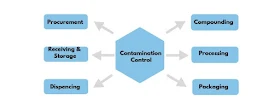Contamination is a very serious issue in pharmaceutical manufacturing especially in sterile manufacturing. It is important to control the contamination in the pharmaceutical manufacturing area to protect the product. There are many ways of contamination so there are different strategies to control it. This article provides some strategies to control contamination in pharmaceutical production.
Pharmaceutical manufacturing areas may have different types of equipment and contaminations. Contamination control is the most important aspect of pharmaceutical manufacturing. There is a variety of sources of contamination such as environment, employees and material.
Installation of Air Filters: Particulate matter, bacteria, fungi and viruses are removed from the air by the filters called HEPA filters. These filters are installed in the air handling units to supply the contamination-free air in the manufacturing area. This method helps to minimize the microbial contamination in the area.
Use of Barriers: Barriers in the form of tanks or filters are used to control the contamination between two areas. Pass boxes and airlocks are the widely used barrier systems in the pharmaceutical industry.
Use of Disinfectants: Disinfectants are very useful to control and eliminate the contamination from floor, equipment and air. Cleaning the floor using disinfectants is very effective in contamination control. Fogging and spraying the disinfectant is useful for air decontamination.
1. Prevention: Prevention is the method used to avoid the creation of contamination means to remove the source of contamination.
2. Detection: Detection is the identification of the contamination by using the appropriate ways as applicable.
3. Cleanup: Cleanup is to remove the contamination wherever it is detected by the use of appropriate methods by cleaning, sanitization or decontamination.
4. Mitigation: Mitigation is the use of preventive measures to ensure that the same contamination event will not happen in the future.
Pharmaceutical manufacturing areas may have different types of equipment and contaminations. Contamination control is the most important aspect of pharmaceutical manufacturing. There is a variety of sources of contamination such as environment, employees and material.
Contamination Control Systems in Pharmaceutical Manufacturing
Pharmaceutical manufacturing requires effective contamination control systems because it is the most regulated industry and requires the safety and efficacy of the products. Pharmaceutical products are manufactured in controlled and sterile environments in order to produce safe and effective products.Installation of Air Filters: Particulate matter, bacteria, fungi and viruses are removed from the air by the filters called HEPA filters. These filters are installed in the air handling units to supply the contamination-free air in the manufacturing area. This method helps to minimize the microbial contamination in the area.
Use of Barriers: Barriers in the form of tanks or filters are used to control the contamination between two areas. Pass boxes and airlocks are the widely used barrier systems in the pharmaceutical industry.
Use of Disinfectants: Disinfectants are very useful to control and eliminate the contamination from floor, equipment and air. Cleaning the floor using disinfectants is very effective in contamination control. Fogging and spraying the disinfectant is useful for air decontamination.
How does a Good Contamination Control System Look like?
An ideal contamination control system must be effective to control the contamination and should safeguard the product as well as the personnel working in the area. A good contamination control system should have four components.1. Prevention: Prevention is the method used to avoid the creation of contamination means to remove the source of contamination.
2. Detection: Detection is the identification of the contamination by using the appropriate ways as applicable.
3. Cleanup: Cleanup is to remove the contamination wherever it is detected by the use of appropriate methods by cleaning, sanitization or decontamination.
4. Mitigation: Mitigation is the use of preventive measures to ensure that the same contamination event will not happen in the future.



No comments:
Post a Comment
Please don't spam. Comments having links would not be published.